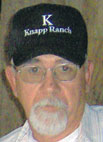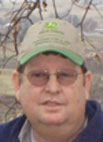Poultry, Locally
Just off highway 82 in northeastern Oklahoma, there is a green metal barn housing one innovative poultry business. The flock of chickens cared for there is among the healthiest possible, and is produced with several all-natural methods.
Grass, Good Cattle and Grandkids
John Ely has been in the grass business for more than 40 years.
A Positive Outlook for Beef
Jimmy Stephens was born into a family that gave him two dreams. One of those dreams, or passions, as Jimmy called it, stemmed from riding around in the pickup truck with his grandfather when he was a young boy, while he checked cattle. The other dream stemmed from an uncle that worked in law enforcement. Jimmy started working in law enforcement first, by becoming an Arkansas State Trooper, but he still had a longing to have a ranch of his own. So, in 1995, Jimmy bought a ranch just off of I-40 Interstate, with a creek running through it. He raises registered Black Angus and Brangus cattle, and has built a working barn and pens along with a dog kennel for his Catahoula cow dogs.
What’s Important In A Cow
Except for four years attending college, 49-year-old Carl Button has lived his entire life on the family farm near Urbana, Mo., in Hickory County. His Grandfather Meier purchased the farm in 1950. In the mid 1960’s, Carl’s father bought the farm and added more land to it, eventually expanding it to 500 acres. Today the farm is divided between Carl and his brother and sister. He owns 160 acres of the family farm plus another 80 acres in Dallas County. Married 25 years, Carl and wife, Gayla, have three grown children.
Keeping Almost Perfect Cattle
"There’s no such thing as a perfect breed of beef cattle,” Frank Skym said, “but Braunvieh have so many good characteristics, they have to be close.” The quality of the beef and feed efficiency are close to the top of the list of characteristics Frank appreciates in his herd. Braunvieh cattle average a feed conversion of 6.71 pounds per pound of gain, according to the Braunvieh Association of America. Even though Braunvieh are heavily muscled, their marbling ensures a high grade of beef.
Goats Are Still Livestock
Patti Black’s enthusiasm over her LaMancha and Sable dairy goats that she raises with her 15-year-old son, Travis, is contagious. “LaManchas are the only breed of goat that is native to America,” she explained. “They are quiet, gentle, docile, very even-tempered animals, which makes them good for someone like me, who has close neighbors.”
A Charolais Bull Can’t Be Wrong
The Talihina, Okla., area – talk about scenic beauty. Some of the best scenery in the world can be found right in the backyard of Gerald and Jana Knapp, owners of Knapp Ranch. The Knapps raise Charolais bulls, even though with the wet and snowy weather of late, those bulls have been more brownish-gray in color.
Reasons For Limousin
You can take the boy out of the farm, but you can't take the farm out of the boy. Yes, Bill Schaeffer is pastor of Bible Baptist Church in Omaha, Ark., and head of its preschool through 12th grade school. And, yes, he runs Schaeffer Cedar Sawmill. But at heart he’s first a farmer who loves the Limousin cattle he’s raised since 1998.
A Mixed Feed For Their Cattle
Ralph Moore, of Lincoln, Ark., has spent the better part of his adult life around Simmental cattle. And that's just how he wants it to be.
His Cattle Will Work On Grass
On a well-maintained farm near Crane, Mo., Jim and Anne Jones care for a select herd of Red and Black Angus cattle, along with some mixed breed commercial cattle. "This place was pretty rough when we bought it five years ago," Jim said. "We’ve built every building, corral and fence on the place, cleared the brush from the fence rows and replaced the native grasses with modern grazing grasses," Jim said.











